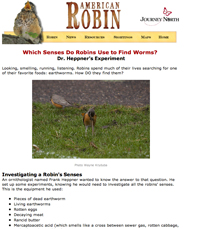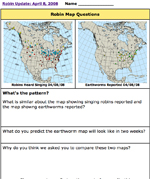Your Sightings! >>
Today's Report Includes:
- The Migration: Maps and Highlights
- Make Connections: Got Worms?
- Journal: How Do Robins Find Worms?
- Investigate: Northern Outpost News

Can
you find the robin?
Look closer: >>
|
|
Highlights:
Waves of 200-300 robins are still being reported in some places, and many of you were surprised to see or hear robins despite cold or snow: "I finally heard my first robin song this afternoon! We still have so much snow (2 feet on the ground in our yard in Norwich, VT), that I have only begun to see robins regularly in the neighborhood. It seemed so late, yet looking at my records from the past few years I see this year is identical to _________ and only 10 days later than the earliest in _________." (We thought you'd like to fill in the blanks with the information below!)
An observer from Whitewater, WI sums up: "I always see waves of male robins first. Then the males begin to sing and a few days after that I begin to see female robins." It happened April 3! What's happening where you live? Share the excitement by reporting to: Robin (OTHER observations) |
Photo Study >> |
|
"Robins landed en-mass. Every lawn has a robin on it, defending its territory. No females yet." Port Hope, ON 03/28/08  Often male and female birds of the same species look different. A quick look at robins might make you think that they all look the same, but is this really true? Study this photograph showing a pair of robins. One is male and one is female. You decide whether the birds look the same >> |
Your Earthworms! >>
Here's what you're reporting this week about one of a robin's favorite foods:
- "I saw my first large earthworm of the season, just before a robin swallowed it." East Amherst, NY, April 5
- "Today (April 4) we spotted some earthworms outside during our field trip. It was a rainy day and many of the worms appeared to be not alive." Stafford Springs, CT fifth grader
An observer at Waterloo Elementary in Iowa summed it up: "The robins will welcome their arrival." But how do the robins find these morsels?
This Week's Map Questions Handout >>
An
ornithologist named Frank Heppner wanted to find out which senses robins
used to find worms. He set up some experiments to investigate all the
robins' senses. This
is the
equipment
he used:
Pieces of dead earthworm
Living earthworms
Rotten eggs
Decaying meat
Rancid butter
Mercaptoacetic acid (which smells like a cross between sewer gas,
rotten cabbage, a skunk, and a stinkbug)
A small drill
A tape recorder that was extremely sensitive at low frequencies
- If you had the materials Frank Heppner used, how would you design experiments to prove which sense(s) robins use to find worms? Why do you think he used each of these materials?
Write your ideas in your Robin Journal. Then add to your entry after you read more about Dr. Heppner's experiments and conclusions. >>

How many Northern Observation Posts (NOPs) — the yellow stars on the robin maps — are still waiting to see or hear their first robins? See the latest news from observers at the end of the robins' migration trail:
- See today's NOP comments to aid your predictions.
- See a letter from the teacher at Innoko River School to answer: What scientific data are the students gathering for the sixth year?
- Observe (Checklist): Spring Phenology of Robins >>
- Listen: Play Name That Tune >>
- Discover: Worm Hunt: Collecting and Observing Earthworms >>
- Investigate: Disappearing Act: Escaping Predation >>
- Identify: Exploring in the Field: Male or Female Robin? >>
- Contribute: Report Your Robin Sightings >>
- Imagine: A Day in the Life of a Migrating Robin >>

Photo Elizabeth Howard
Can
you see two clues that tell you it's a cold day in the early spring? >>
The Next American Robin Migration Update Will Be Posted on April 15, 2008.








